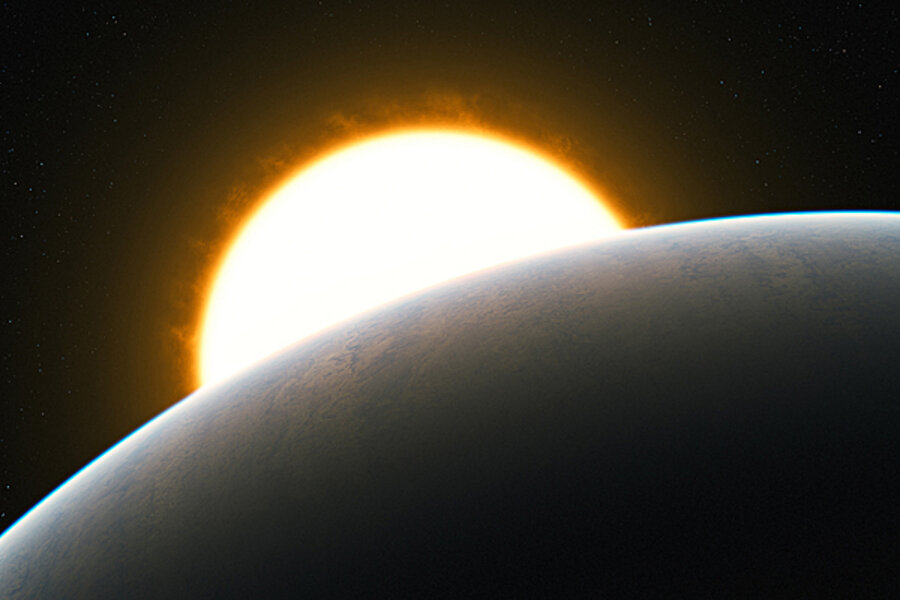A planet with 4,500-m.p.h. winds? Now that's a superstorm.
Loading...
If you're planning a trip to planet HD 209458b (not recommended for several reasons), hold on to your hat. Astronomers have just clocked the planet's high-altitude winds at a hair less than 4,500 miles per hour.
"Measured winds on Jupiter and Saturn are only a fraction of this," notes Leiden University astronomer Ignas Snellen, who led a team of researchers probing the extrasolar planet's traits. The closest competitor our solar system can offer up is Neptune, with winds speeds estimated as high as 1,200 m.p.h.
The measurement, reported in Wednesday's issue of the journal Nature, in effect was a byproduct of efforts to look at a now-familiar extrasolar planet with sharper eyes, adds team member and astronomer Simon Albrecht.
In this case, the team was using a relatively new spectrograph at the European Southern Observatory's Very Large Telescope array in Chile to confirm previous observations and see what more the spectrograph might reveal.
The results "were more than we hoped for," says Dr. Albrecht, who splits his time between Leiden University and the Massachusetts Institute of Technology. Not only was the team able to detect wind speeds on a planet 150 light-years away. But the scientists were also able to measure the pace of its orbit with far higher precision, which in turn allowed them to make simpler, more direct calculations of the planet's mass than predecessors have been able to use.
The effort highlights the increasingly detailed information astronomers are gathering as they aim giant ground-based telescopes at some of the extrasolar planets nearest our solar system.
So far, astronomers have found 463 planets outside the solar system. The latest discoveries were unveiled last week, when scientists using the French CoRoT satellite added six planets to the extrasolar planet catalog.
HD 209458b a 'hot Jupiter'
Meanwhile, the National Aeronautics and Space Administration's Kepler mission last week released its first 43 days' worth of data on some 156,000 stars in the vicinity of the constellations Cygnus and Lyra. The team is paying special attention to some 400 of these stars in hopes of detecting planets orbiting them.
Many of the extrasolar planets discovered are so-called hot Jupiters – gas giants that orbit very close to their parent star.
Among these hot Jupiters, none has come under as close scrutiny as HD 209458b, which orbits a star in the constellation Pegasus. Astronomers discovered the planet in 1999, and it's been a target for ground- and space-based telescopes ever since.
The man reason: Its star is relatively close to Earth and very bright, making the system easier to observe in a relatively short period of time.
Among the discoveries: It's one planet to scratch from a cosmic TripTick. It orbits its host star at a distance of 4.3 million miles, compared with 36 million miles for Mercury, the planet closest to our sun. One circuit around the star lasts 3.5 days. Astronomers estimate its temperature at roughly 1,600 degrees Fahrenheit.
To add insult to injury, the planet appears to be evaporating. In 2003, a team of astronomers led by Alfred Vidal-Madjar with the Institute for Astrophysics in Paris found that the planet's stock of hydrogen was streaming into space, much like a comet's tail.
In a paper accepted for publication in an upcoming issue of the Astrophysical Journal, a team led by University of Colorado astrophysicist Jeffery Linsky estimates that HD 209458b is shedding 88,000 to 441,000 tons of material each second. Kiss it good-bye in 96 million to 482 million years.
How they figured the wind speed
In the Nature results, Dr. Snellen and colleagues used the planet's carbon-monoxide (CO) signature – detected as starlight passed through the planet's atmosphere – as their marker. From changes over time in that signature compared with a known standard, the team derived the planet's orbital speed and calculated its mass as 64 percent of Jupiter's mass.
As a bonus, the high-resolution infrared spectrograph the team used picked up another shift in the CO's spectral signature. It indicated that winds in the planet's upper atmosphere were blasting their way from the day side to the night side of the planet. The magnitude of this shift allowed them to estimate the speed of the CO's movement – some 4,500 m.p.h.
At this point, researchers are still trying to figure out how much cooler the night side is than the day side. One would expect winds flowing from the day side to the night side to spread that heat around the planet.
A similar planet around another star appears to shows a day-night temperature difference of a scant 80 degrees F., Snellen explains. But HD 209458b's difference may be substantially greater, he says, because it appears that the upper atmosphere on the day side does a good job of re-radiating heat from the star back into space, allowing for cooler temperatures deeper in the atmosphere.
This explanation requires "a long chain of arguments for which there is not – yet – a lot of evidence," he cautions.
Related:





